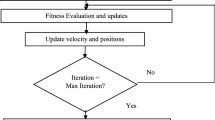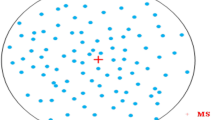Abstract
Due to small battery powered devices and inefficient utilization of resources, the sensor nodes in Internet of Things (IoT) may be lost prematurely. In order to extend the lifetime and avoid energy-hole problem, a novel hierarchical data aggregation with particle swarm optimization for Wireless Sensor Networks (HDA-PSO) is proposed. Firstly, the fitness function is designed from multiple relational matrices, including the residual energy, the average distance among adjacent nodes and the centroid degree of the covering region. Secondly, in order to effectively encircling the optimal solution with initial position of particles, we propose a population initialization method based on beta distribution according to the distribution characteristics of nodes in sensor networks. Next, based on differential evolution, a novel operator is introduced for velocity update which effectively balances the exploration and development of particle swarm optimization. The experimental results show that the proposed algorithm can effectively balance the energy consumption of nodes under different node’s density, improve the energy efficiency and prolong the lifetime of network significantly.





Similar content being viewed by others
References
Jia M, Gu X, Guo Q, Xiang W, Zhang N (2016) Broadband hybrid satellite-terrestrial communication systems based on cognitive radio toward 5G. IEEE Wirel Commun 23(6):96–106
Lin Y, Zhu X, Zheng Z et al (2017) The individual identification method of wireless device based on dimensionality reduction and machine learning. J Supercomput 5:1–18
Tu Y, Lin Y, Wang J et al (2018) Semi-supervised learning with generative adversarial networks on digital signal modulation classification. CMC-Computers Materials & Continua 55(2):243–254
Jia M, Liu X, Gu X, Guo Q (2017) Joint cooperative spectrum sensing and channel selection optimization for satellite communication systems based on cognitive radio. Int J Satell Commun Netw 35(2):139–150
Thilagavathi S, Gnanasambandan Geetha B (2015) Energy aware swarm optimization with inter-cluster search for wireless sensor network. Sci World J 25:1–8
Demigha O, Hidouci W-K, Ahmed T (2013) On energy efficiency in collaborative target tracking in wireless sensor network: a review. IEEE Communications Surveys & Tutorials 15(3):1210–1222
Zungeru AM, Ang L-M, Seng KP (2012) Classical and swarm intelligence based routing protocols for wireless sensor networks: a survey and comparison. J Netw Computr Appl 35(5):1508–1536
Izadi D, Abawajy JH, Ghanavati S et al (2015) A data fusion method in wireless sensor networks. Sensors 15:2964–2979
Heinzelman W R, Chandrakasan A, Balakrishnaneth, (2000) Energy-efficient communication protocol for wireless microsensor networks, In: proc. of the 33rd Hawaii International Conference on System Sciences, Washington DC: IEEE Computer Society, pp: 4–7
Wu L, Du J, Nie L et al (2015) Cluster head selection method using dynamic k value for wireless sensor network. Journal of Huazhong University of Science and Technology (Nature Science Edition) 43(10):37–41
Jiang H, Liu W, Wang X (2014) Research and improvement of LEACH-C routing protocol in wireless sensor network. Microelectronics & Computer 12(31):43–47
Ever E, Luchmun R, Mostarda L, et al. (2012) UHEED: an unequal clustering algorithm for wireless sensor networks, In: Proc. of the 1th international conference on sensors networks, pp: 185–193
Aierken N, Gagliardi R, Mostarda L, et al. (2015) RUHEED- rotated unequal clustering algorithm for wireless sensor networks, In: Proceedings of the 2015 IEEE 29th international conference on advanced information networking and applications workshops. Piscataway, NJ: IEEE, 170–174
Olariu S, Stojmenovic I., (2006) Design guidelines for maximizing lifetime and avoiding energy holes in sensor networks with uniform distribution and uniform reporting, In: Proceedings of the 2006 25th IEEE international conference on computer communications. Piscataway, NJ: IEEE, 1–12
Ren LJ, Guo ZW, Tang RC (2008) A node placement strategy based on energy balance for wireless sensor networks. Periodical of Ocean University of China 38(5):841–844
Liu Z, Guo H (2013) Study on concentric ring and cluster-based energy hole avoiding method in wireless sensor networks. Computer Science 40(12):147–151
Wu YC, Li WQ, Hu Z et al (2015) A sub-ring-based clustering routing protocol for energy-efficient WSNs. Transducer and Microsystem Technologies 34(5):8–11
Chen HN, Liu GC, Wu XL et al (2015) Clustering protocol based on genetic algorithm and probabilistic forwarding. Computer Science 42(3):71–73
Rahmanian A, Omranpour H, Akbari M et al (2011) A novel genetic algorithm in LEACH-C routing protocol for sensor networks. In: Proc of Canadian Conference on Electrical and Computer Engineering:1096–1100
Jiang J (2011) Optimization of wireless sensor network LEACH protocol based on PSO algorithm. Journal of Soochow University (Engineering Science Edition) 33(1):1–5
Jiang C, Tang X, Xiang M (2012) Research on non uniform clustering routing protocol for wireless sensor networks based on PSO. Computer Application Research 29(8):3074–3077
Ye Z et al (2014) Adaptive clustering based dynamic routing of wireless sensor networks via generalized ant colony optimization. In: Proc of International Conference on Future Information Engineering 10:2–10
Kennedy J, Eberhart R. (1995) Particle swarm optimization, In: Proceedings of IEEE International Conference on Neural Networks, 1942–1948
Huang Z, Shan G, Cheng J, Sun J (2018) TRec: an efficient recommendation system for hunting passengers with deep neural networks. Neural Comput & Applic 31:209–222. https://doi.org/10.1007/s00521-018-3728-2
Zungeru AM (2012) Classical and swarm intelligence based routing protocols for wireless sensor networks: a survey and comparison. Elsevier J Netw Comput Appl 35:1508–1536
Yu J, Qi Y, Wang G, Gu X (2012) A cluster-based routing protocol for wireless sensor networks with nonuniform node distribution. AEU-Int J Electron Commun 66:54–61
Wu B, Zong L, Yan X, Guedes Soares C (2018) Incorporating evidential reasoning and TOPSIS into group decision-making under uncertainty for handling ship without command. Ocean Eng 164:590–603
Yong Q (2011) Information potential fields navigation in wireless ad-hoc sensor networks[J]. Sensors 11(5):4794–4807
Xu Q, Wang L, Hei XH, Shen P, Shi W, Shan L (2014) GI/Geom/1 queue based on communication model for mesh networks. Int J Commun Syst 27(11):3013–3029
Yang XL, Shen PY et al (2012) Holes detection in anisotropic sensornets: topological methods. International Journal of Distributed Sensor Networks 8(10):135054
Srivastava HM, Zhang Y, Wang L, Shen P, Zhang J (2014) A local fractional integral inequality on fractal space analogous to Anderson's inequality. Abstract and Applied Analysis Hindawi Publishing Corporation 46(8):5218–5229
Qiang Y, Zhang J (2013) A bijection between lattice-valued filters and lattice-valued Congruences in Residuated lattices. Math Probl Eng 36(8):4218–4229
Wu B, Yan X, Wang Y, Guedes Soares C (2017) An evidential reasoning-based CREAM to human reliability analysis in maritime accident process. Risk Anal 37(10):1936–1957
Kuila P, Jana PK (2014) A novel differential evolution based clustering algorithm for wireless sensor networks. J Appl Soft Comput 25:414–425
Pal R, Sharma AK, (2013) FSEP-E: enhanced stable election protocol based on fuzzy logic for cluster head selection in WSNs,” In: Proceedings of the sixth international conference on contemporary computing (IC3), Noida, India, 8–10 August, pp. 427–432
Jia M, Yin Z, Guo Q, Liu G, Gu X Waveform Design of Zero Head DFT spread spectral efficient frequency division multiplexing. IEEE ACCESS 5:16944–16952
Lin Y, Li Y, Yin X et al (2018) Multisensor fault diagnosis modeling based on the evidence theory. IEEE Trans Reliab 20(99):1–9
Author information
Authors and Affiliations
Contributions
Xueqiang Yin conceived the study and performed the simulation experiments and wrote the paper. Shining Li reviewed and edited the manuscript. All authors read and approved the final manuscript.
Corresponding author
Ethics declarations
Competing Interests
The authors declare that they have no competing interests.
Additional information
Publisher’s Note
Springer Nature remains neutral with regard to jurisdictional claims in published maps and institutional affiliations.
Rights and permissions
About this article
Cite this article
Yin, X., Li, S. & Lin, Y. A Novel Hierarchical Data Aggregation with Particle Swarm Optimization for Internet of Things. Mobile Netw Appl 24, 1994–2001 (2019). https://doi.org/10.1007/s11036-019-01333-4
Published:
Issue Date:
DOI: https://doi.org/10.1007/s11036-019-01333-4




